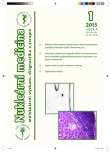Role of sentinel node in breast cancer
Authors:
M. Brychta
Authors‘ workplace:
Radioterapeutická a onkologická klinika, 3. LF UK a FNKV, Praha 10, ČR
Published in:
NuklMed 2015;4:2-3
Category:
Editorial
Sources
1. Giuliano AE, Hunt KK, Ballman KV et al. Axillary dissection vs no axillary dissection in women with invasive breast cancer and sentinel node metastasis: a randomized clinical trial. JAMA 2011;305:569-575
2. Galimberti V, Cole BF, Zurrida S et al. Axillary dissection versus no axillary dissection in patients with sentinel-node micrometastases (IBCSG 23-01): a phase 3 randomised controlled trial. Lancet Oncol 2013;14:297–305
3. Gatzemeier W, Mann BG. Which sentinel lymph-node (SLN) positive breast cancer patient needs an axillary lymph-node dissection (ALND) – ACOSOG Z0011 results and beyond. Breast 2013;22:211-216
4. Morrow M, Giuliano AE. To cut is to cure: can we really apply Z11 in practice? Ann Surg Oncol 2011;9:2414–2415
5. Goldhirsch A, Wood WC, Coates AS et al. Panel members. Strategies for subtype – dealing with the diversity of breast cancer: highlights of the St. Gallen International Expert Consensus on the Primary Therapy of Early Breast Cancer 2011. Ann Oncol 2011;22:1736–1747
6. Goldhirsch A, Winer EP, Coates AS, et al. Personalizing the treatment of women with early breast cancer: highlights of the St Gallen International Expert Consensus on the Primary Therapy of Early Breast Cancer 2013. Ann Oncol 2013;24:2206–2223
7. Šimánek M, Abrahám V, Hruška J. Indikace axilární disekce uzlin při nálezu mikrometastatického postižení sentinelové uzliny u karcinomu prsu. NuklMed 2015;1:4-7
Labels
Nuclear medicine Radiodiagnostics RadiotherapyArticle was published in
Nuclear Medicine

2015 Issue 1
Most read in this issue
- Indication of the axillary lymph node dissection in micrometastatic lymph node involvement of breast cancer
- Role of sentinel node in breast cancer
- Internal and external clinical audit in nuclear medicine
- Comparison of whole body bone scintigraphy with levels of the serum concentration of human epididymal protein 4 in patients with malignant melanoma
